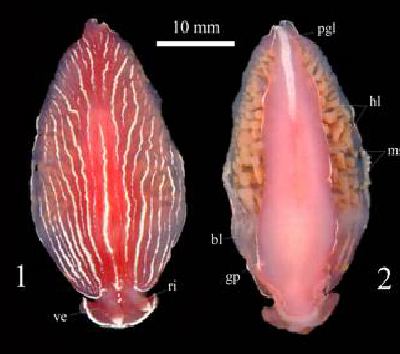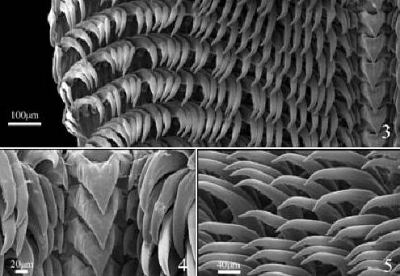
Armina juliana
Ardila & Diaz, 2002
Order: NUDIBRANCHIA
Suborder: ARMININA
Family: Arminidae
DISTRIBUTION
Caribbean
PHOTO
Type material: Holotype (Figures. 1 and 2) deposited in the Reference Collection of the Instituto de Investigaciones Marinas y Costeras, INVEMAR, at Santa Marta, Colombia (INVEMAR-Mol-1598), length 41 mm alive, loc. off Cabo de La Vela, Colombia (12º 19´ N, 72º 42´ W), 460 m, muddy bottom. Paratype, deposited in the Natural History Museum of Los Angeles County, Los Angeles, CA, USA (LACM-2908), length 14 mm alive, loc. off Palomino, Colombia (11º 26´ N, 73º 32´ W), 306-312 m, muddy bottom.
SEM photographs: holotype. 3. Radula, 4. Rachidian tooth, 5. Lateral teeth, 6. Jaws. 6. Jaw rodlets
The living animals are bright red in color with contrasting white longitudinal notal ridges; the anterior margin of the oral veil and the apical portion of the rhinophores are also white (Figure. 1). The body is elongated, flattened, narrowing posteriorly. The notum bears 34 longitudinal dorsal ridges, the oral veil is distinct and the club-shaped rhinophores, bear about 10 vertical lamellae. A caruncle is also distinguishable in front of the rhinophores. The genital opening is located on the right side, anterior to the branchial lamellae. There were approx 20 branchial lamellae on each side of the body, and 15 hyponotal lamellae. A deep medial groove is present along the sole of the foot (Figure 2) and the posterior white pedal gland is prominent. The radula has the formula 27 X 32.1.1.1.32 (holotype) (Figure 3). The rachidian tooth is broad (112 µm) and bears 12 elongated denticles on either side of the median cusp (Figures 3 and 4). The first lateral tooth is short, bulky and denticulated on the outer side of the cusp. The remaining lateral teeth are elongated and also bear denticles which become progressively smaller towards the marginal tooth rows (Figure 5). The jaws have a denticulated masticatory border (Figure 6), and a long masticatory process (Figure 7). Each process bears four rows of denticles (Figure 7).
This species was collected off the northern Caribbean coast of Colombia at depths of 310 and 460 m in soft bottom sediments. A. juliana is the first record of the genus Armina and the family Arminidae in the Caribbean Sea and after A. tigrina, A. abbotti, A. muelleri and A. wattla, see Kolb and Wägele, 1998, it is the fifth arminid known to occur in western Atlantic waters. Moreover, except for the new species, no other species of Armina has been yet recorded from waters deeper than 200 m in the western Atlantic.
Reference:
• Ardila, N. E. & Díaz, J.M. (2002) Armina juliana (Gastropoda: Nudibranchia: Arminidae), a new species from the southern Caribbean. Bol. Instituto de Investigaciones Marinas y Costeras, 31: 25-31.
• Kolb, A. (1998) Morphology, anatomy and histology of four species of Armina Rafinesque, 1814 (Nudibranchia, Arminoidea, Arminidae) from the Mediterranean sea and the Atlantic Ocean. J. Moll. Stud., 64: 355-386.
• Kolb, A. and H. Wägele. (1998) On the phylogeny of the Arminidae (Gastropoda, Opisthobranchia, Nudibranchia) with considerations of biogeography. J. Zool. Syst. Evol. Research, 36: 53-64.


Rudman, W.B., 2003 (February 25) Armina juliana Ardila & Diaz, 2002. [In] Sea Slug Forum. Australian Museum, Sydney. Available from http://www.seaslugforum.net/factsheet/armijuli
